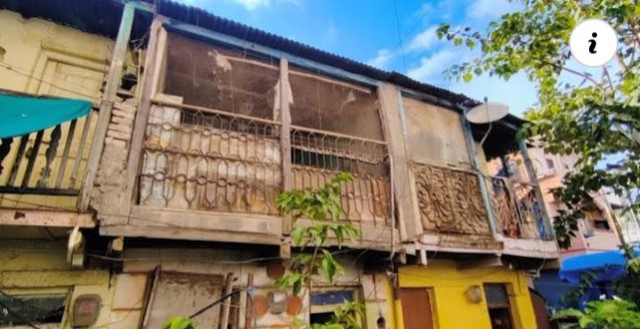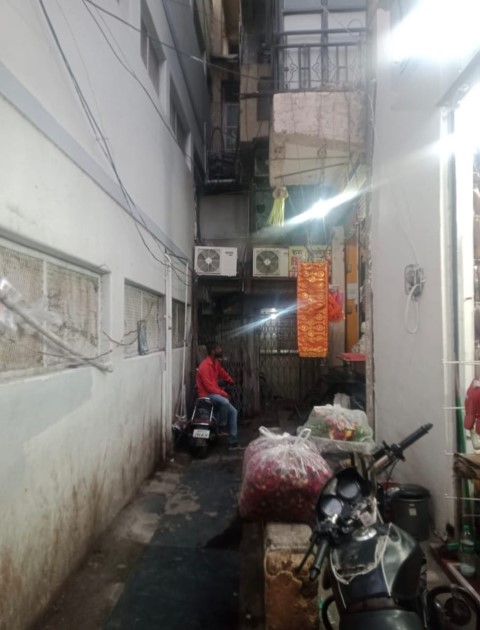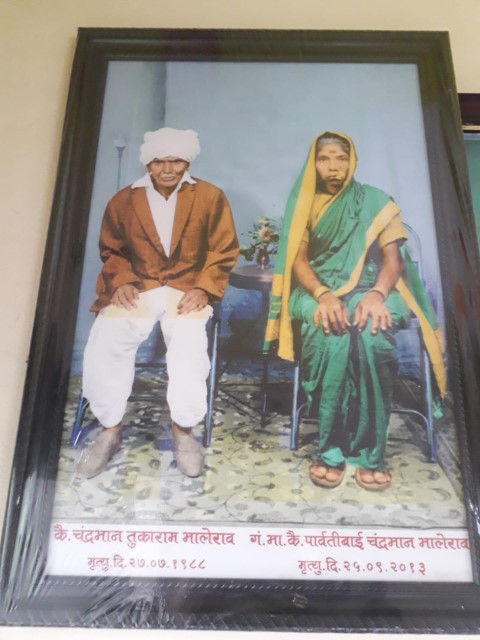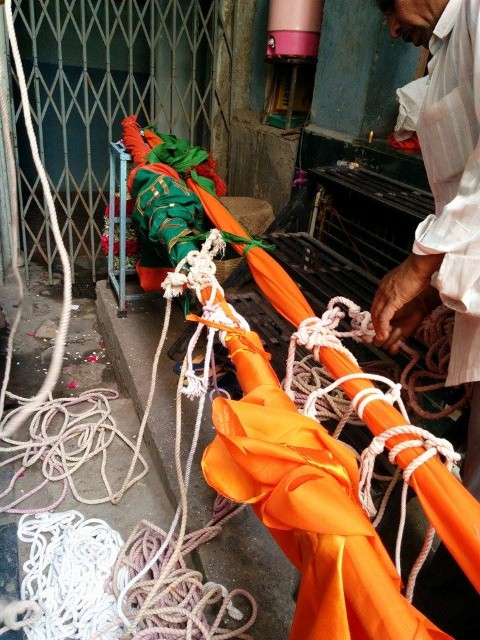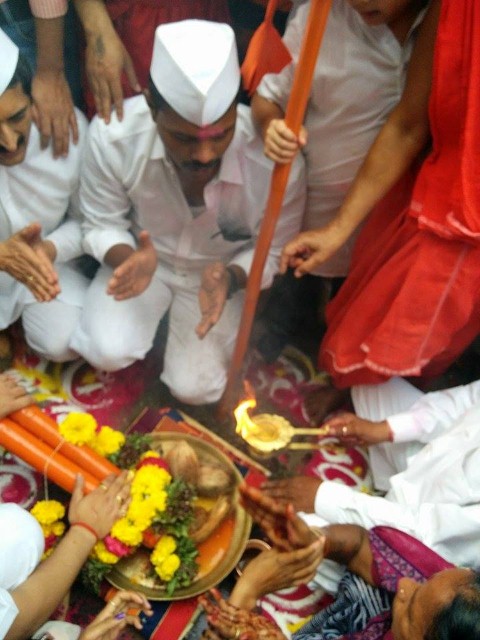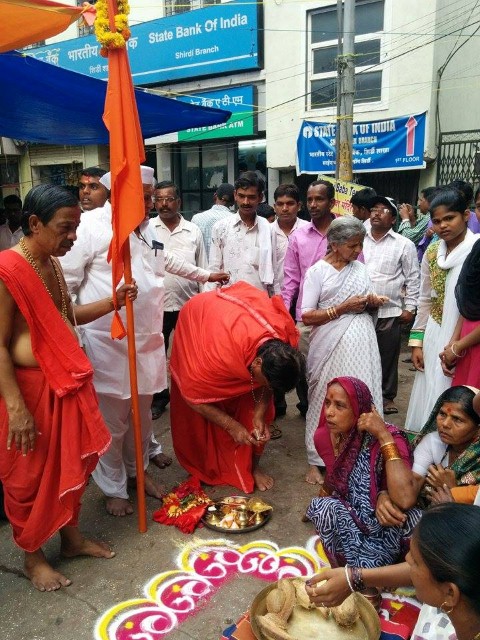|
Tukaram Sutar’s surname was Bhalerao and he was a carpenter or Sutar by profession. Hence Baba used to call him as “Sutar” and rest of the devotees also followed suit and the surname continued. This house is situated in front of the Vittal Mandir. It is in the narrow line going from Pilaji Gurav’s home to Seva Dham. The house has an “OM” inscribed above the entrance.
Sutar's Ancestral Home in Shirdi
Tukaram Sutar Ancestral Home Outerview
Meerabai Bhalerao Great Grand Daughter-in-Law & Sandeep Bhalerao Great Grandson of Tukaram Sutar Tukaram had two more brothers namely Kondaji and Gabaji. Baba loved the three brothers a great deal, but Tukaram was very dear to him. The three brothers were instrumental in making the Dwarakamai as we know it today. They provided the greatest help. All the wood work of Dwarakamai Masjid was done by them. After the renovation the management of the Masjid continued with them for many years. Till Baba’s Mahasamadhi, Tukaram undertook the sweeping of the Masjid. He took care of Baba’s needs like heating of water, and giving it to him to wash his face and mouth. Baba would not allow any other person to do this as he loved him a lot. Kondaji did not have any children. His brother Gabaji had two wives Parvatibai and Saibai. He had one son named Gangadhar from Saibai. Tukaram had also had two wives namely Sundrabai and Geetabai. He had four sons. The descendants of Tukaram used to live in this home till 2009. Now they have built a house and moved to an area behind Sai Nagar.
Tukaram's Son Late Shri.Chandrabhan Tukaram Bhalerao The most important thing that this family did was to make a staff about 30’ long. This staff is a bamboo staff that they bring from a place called Madhi, every year. About a month before Ram Navami, this staff is brought to their home. It is cleaned and numerous coats of varnish are applied on it. In Marathi it is called “Kathi” and a ritualistic worship of it is performed. This staff is used in the Ram Navami celebrations of “Changing of the Flags ceremony”. Every year Ram Navami day the flags arrive from Damu Anna’s home at Ahmednagar. Another flag comes from Nimonkar home at Pune. Upon reaching Shirdi the flags are taken to the Samadhi Mandir, and the Samadhi is draped with them. Then the noon Aarti takes place. At about 3:30 PM they are taken to the Sutar home and puja is performed. When the flags are taken from the Samadhi Mandir to the Sutar house they are carried on a silver platter. In the Sutar home puja is performed. After the Aarti the flags are hoisted on this staff by the descendants of Tukaram Sutar. This is a great honor bestowed on the family by the Sansthan.
Preparing the Flags for Performing Pooja
Sandeep Bhalerao performing Flag Pooja
Shri Sai Baba Sansthan Purohit performing Flag Pooja Then the flags on the staff are taken throughout the village in procession. This is a joyous occasion and there is music provided by a local band. Many devotees dance all the way on the route of the procession. After exiting the Sutar home it is taken to the area in front of the Gurav home. There it is joined by another ochre colored flag that is provided by the Sansthan. This flag is finally fixed to the staff, on the grill of the Dwarakamai. Then the procession proceeds to gate number 4 and makes its way to the Gurusthan, then goes to the area in front of the Hanuman Mandir. Here it is joined by the Rath or Chariot. Then the flags lead the procession along the Palkhi route and through the village. Finally, each flag is fixed on a small staff and hoisted atop the Dwarakamai Masjid. As the crowd of devotees who throng to Shirdi has increased by leaps and bounds numerous sacks of Udi are sieved every day. Parvatibai started sieving the Udi from a very young age. At that time the Sansthan gave a very small amount as Dakshina. Now she is about 70 year old and has retired and her daughter-in-law Rukmani is doing this service. Rukmani is given 70 rupees per sack of Udi sieved. We Sai Devotees should be grateful to these ladies. It is because of their dedication that we devotees are getting fine form of Udi Powder. The Sansthan used to send a platter of food to this home after the offering of Baba’s Bhog (a meal offering). With the passage of time this practice was discontinued by the Sansthan. However the descendants of these families consider it a great honor and so they go and collect the bhog themselves. The family is indeed fortunate to receive the Bhog that is offered to Saibaba as Naivedya. (Source: Baba’s Anurag by Sai Bhakta Vinny Chitluri, Photo Courtesy: Smt.Shreya Nagaraj, Pune, Shri.Jignesh C.Rajput, Surat and Shri.Pranav, Telangana) |

